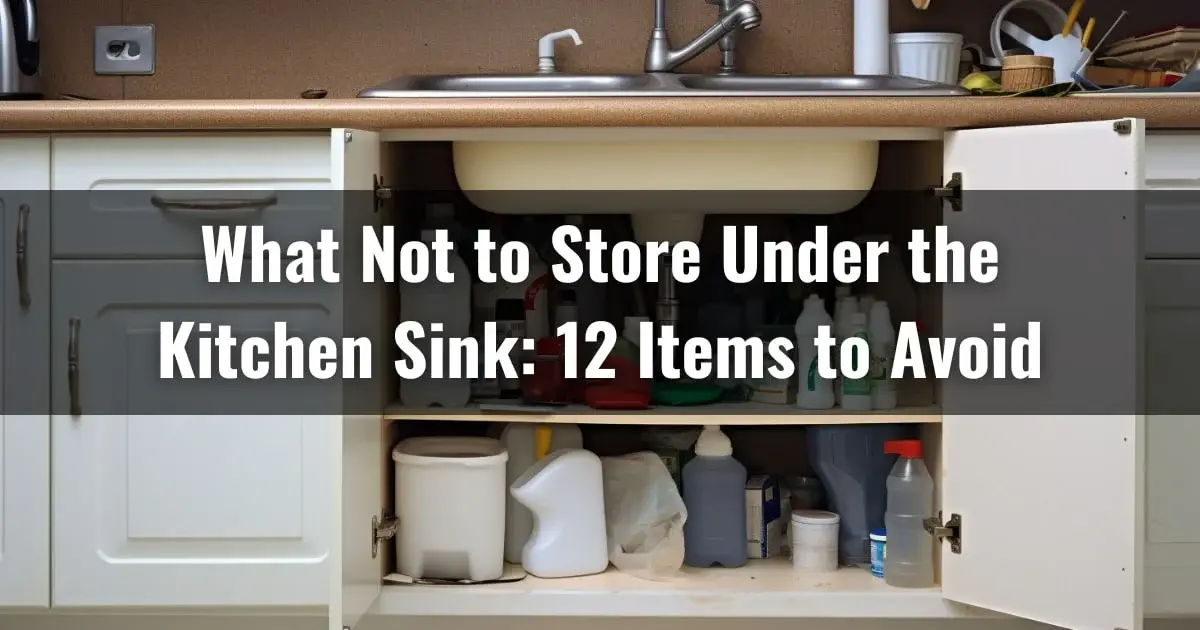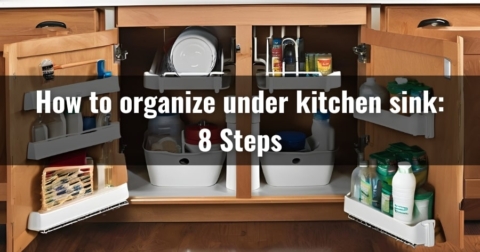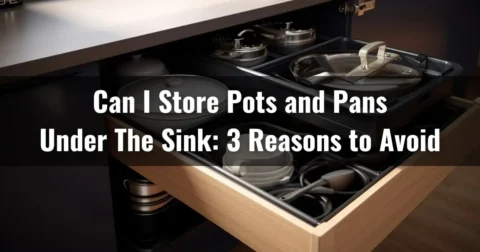Your kitchen’s under-sink area is a valuable storage space, but you need to know what items you should never store in this space. There are some items that you should absolutely avoid placing under your kitchen sink.
Paper towels are one such item, as they are prone to becoming a soggy mess due to plumbing pipes, rendering them unusable. You should also avoid storing pots and pans in this area, as plumbing concerns and moisture can cause rust and corrosion.
In addition, small appliances such as blenders and food processors should not be stored under the kitchen sink.
We’ll talk about what not to store under the sink and what is safe to store there in detail so that your kitchen is organized and safe.
Jump to Section
What Not to Store Under the Kitchen Sink: List of Items
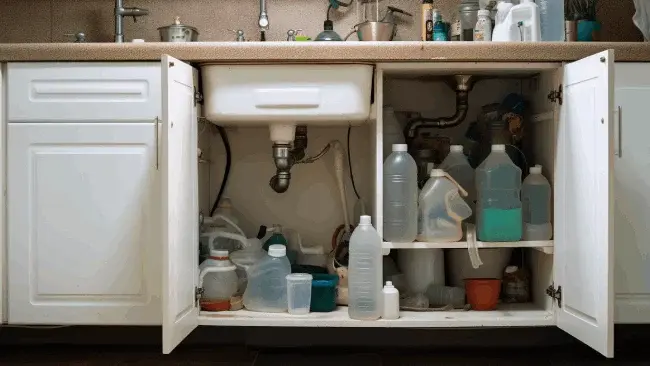
To keep your kitchen organized and safe, here’s a concise list of items you should avoid storing under the kitchen sink:
For a deeper understanding, we now discuss in detail why it is not advisable to store these items under the sink in the kitchen
1. Paper Towels
It is not recommended that you store paper towels under the kitchen sink. Storing paper towels under the kitchen sink can make them damp and unusable due to plumbing pipes.
The constant exposure to moisture can make the paper towels soggy and ineffective for cleaning spills or drying hands.
Additionally, the damp environment can promote mold and mildew growth, which can harm your health.
2. Kitchen Items (Pots and Pans)
You shouldn’t keep pots and pans in there too. Storing them under the sink can lead to rust and corrosion. The moisture accumulating in this area due to plumbing concerns can seep into your cookware, causing damage over time.
Rust and corrosion not only affect the appearance of your pots and pans but can also impact their functionality.
We suggest storing your pots and pans in a designated cabinet or hanging them on hooks to avoid this inconvenience. This will keep them dry and free from potential damage, ensuring they last longer and remain in good condition for all your cooking needs.
3. Small Appliances
To keep your small appliances in good working condition, you should find a different spot to store them rather than under the kitchen sink.
Storing blenders, food processors, or handheld vacuums in a drawer under the sink can expose them to leaks and excess moisture, which can cause damage and shorten their lifespan.
Instead, consider dedicating a specific cabinet or shelf in your kitchen to these appliances. Ensure the area is dry and well-ventilated to prevent any potential moisture-related issues.
4. Harsh Chemicals
You shouldn’t store harsh chemicals under the kitchen sink, either. Storing dangerous chemicals under your sink is strongly discouraged due to several critical safety considerations.
These chemicals, such as bleach and powerful cleaning agents, can be hazardous if they come into contact with plumbing pipes or leaks in the sink cabinet. This can lead to chemical reactions, damage to the pipes, and even potentially harmful fumes in your kitchen.
The close proximity to the ground and easy access in the kitchen make it a risky location, particularly if you have children or pets who might inadvertently reach or spill these chemicals.
5. Flammable Products
Flammable items such as rubbing alcohol, aerosols, and cooking oils should never be kept in this area. These products can easily ignite and cause a fire hazard at home.
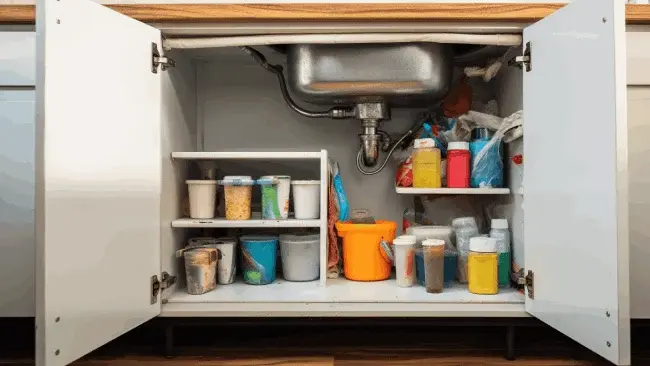
The heat from pipes or electrical outlets under the sink can increase the risk of ignition, making it an unsafe storage location for these items.
Instead, find a designated storage space away from heat sources and open flames for your flammable products.
Consider installing a lockable cabinet or shelf in a well-ventilated area where you can safely store these items out of reach of children and pets.
6. Paint
Keep paint cans and spray paint away from the underside of the kitchen sink. Paint is a highly flammable substance, and storing it near a potential ignition source can lead to disastrous consequences.
The heat generated by gas stoves and ovens can ignite the fumes emitted by paint cans or spray paint, resulting in a fire or explosion.
To ensure the safety of your home and loved ones, find an alternative storage location for these items.
A well-ventilated garage or shed is ideal, as they are far enough from the kitchen and provide proper ventilation to dissipate any hazardous fumes.
7. Food
We also encourage you to avoid storing food, such as Potatoes, Rice, Onions, etc., under your kitchen sink area. Storing it under the sink can cause mold growth due to the humidity in that area.
The high moisture levels in the kitchen sink cabinet create an ideal breeding ground for mold spores, which can contaminate the food. Mold affects the quality of the food and poses a health risk to you and your family.
Moisture from leaky pipes or wet cleaning supplies stored nearby can increase humidity, exacerbating mold growth.
8. Pantry Items
It may seem convenient to store dry goods, spices, or baking supplies under the sink due to limited cabinet space in your kitchen.
However, it’s crucial to avoid doing so. The moist environment underneath the sink can create a breeding ground for mold and mildew, causing these pantry items to deteriorate quickly.
9. Tools
Storing metal tools under the sink can cause rust and corrosion. The moisture in this area can easily seep into the tools, causing them to degrade over time. To prevent this damage, it is recommended that you find an alternative storage solution for your tools.
Consider setting up a designated tool area in your garage or basement, somewhere dry and well-ventilated. Hang your tools on hooks or place them in a toolbox to keep them organized and moisture-free.
10. Light Bulbs
The kitchen sink is not ideal for storing your light bulbs, as the humidity and moisture can cause damage.
Instead, consider finding a more suitable spot for your light bulb storage. A closet or a cabinet in a dry area of your home would be a better option.
11. Dish Towels
Storing clean dish towels under the sink is not advisable, as this area can become dirty quickly.
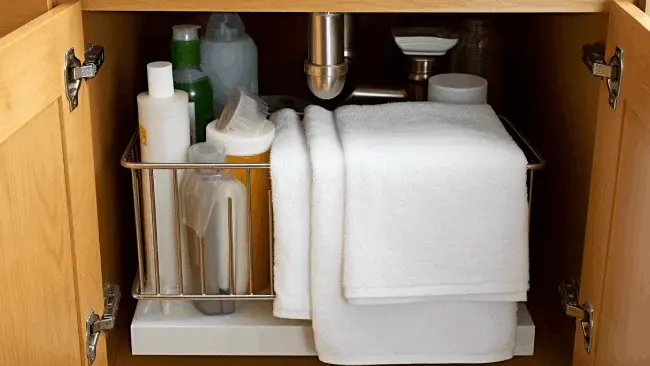
Rather, by hanging your dish towels, you allow them to air dry properly, which reduces the risk of bacteria growing on them. Look for a designated spot near your kitchen sink or on a towel rack where they can hang freely.
This keeps them clean and helps prevent cross-contamination with other items stored under the sink, such as cleaning supplies or garbage bags.
12. Spices
The area under the sink isn’t the best spot for spices because of the dampness. Storing your spices in such a moist environment can lead to their deterioration at a faster rate.
To keep your spices fresh and flavorful, opting for a cooler and drier place in your kitchen is a must. Consider using a cupboard or countertop near your cooking area as an ideal storage space for your spices.
Frequently Asked Questions
We found a lot of people have questions about storing items under kitchen sinks. Therefore, we have gathered some of them in order to assist you.
What is safe to store under the kitchen sink?
Under the kitchen sink, it’s safe to store a selection of items that are conducive to the environment and intended use of the space.
This typically includes everyday cleaning products like all-purpose sprays, dish soap, and glass cleaners with a tight seal for access.
Additionally, using clear containers or tubs to organize supplies, a small recycling bin for managing recyclables, and an absorbent mat to protect against potential leaks are practical choices.
Spare towels or sponges can be kept under the sink as long as they remain dry with proper ventilation.
Moreover, it’s suitable for storing bags, such as garbage bags, recycled bags, and reusable grocery bags, for easy retrieval.
A specialized tool for unjamming garbage disposals can be safely stored under the sink, ensuring it’s readily available for maintenance tasks.
What is the best way to organize under the kitchen sink?
The most effective way to organize under the kitchen sink is to optimize the available space while prioritizing safety and convenience. Start by removing all items from the cabinet to assess what you have and discard any expired or unnecessary items.
Use clear plastic containers or tubs to group similar items together, making it easy to locate and access cleaning supplies, sponges, and other essentials.
Place an absorbent mat at the cabinet’s base to protect against potential leaks and moisture damage.
Install pull-out trays, tension rods, S-hooks, or baskets to create designated spaces for specific items, ensuring they are easily accessible and well-organized.
How do you store cleaning products under the kitchen sink?
To efficiently organize cleaning products under the kitchen sink, utilizing baskets and bins is a highly effective strategy.
Containers with open tops work well for this because they can accommodate items of different sizes, a common feature with cleaning supplies that come in different shapes.
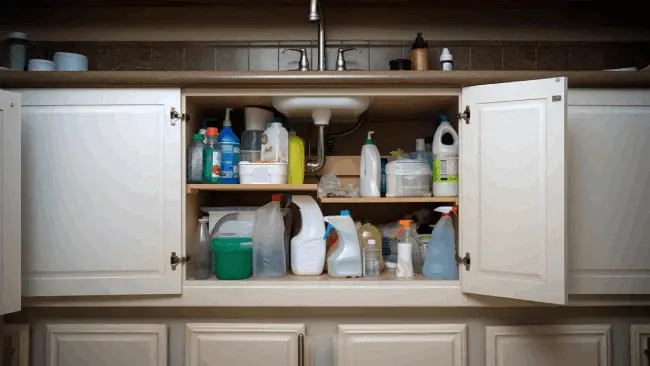
Put your cleaning solutions, sprays, sponges, and brushes in baskets or bins so they’re neatly organized, easy to grab, and clutter-free.
As a result, your kitchen cleaning routine will be more efficient and hassle-free since you can find and use the right cleaning product as needed.
Conclusion
You should be mindful of what you store under your kitchen sink. It is now clear that you should keep certain items out of this area, such as food items, paper towels, pots & pans, small appliances, harsh chemicals, and flammable products.
Instead, utilize the area for items like cleaning supplies, plastic containers, recycling bins, absorbent mats, and handy tools.
Organizing your under-sink space wisely not only keeps your kitchen tidy but also safeguards your home from potential hazards. So, use this storage area to maintain an organized and safe kitchen.
